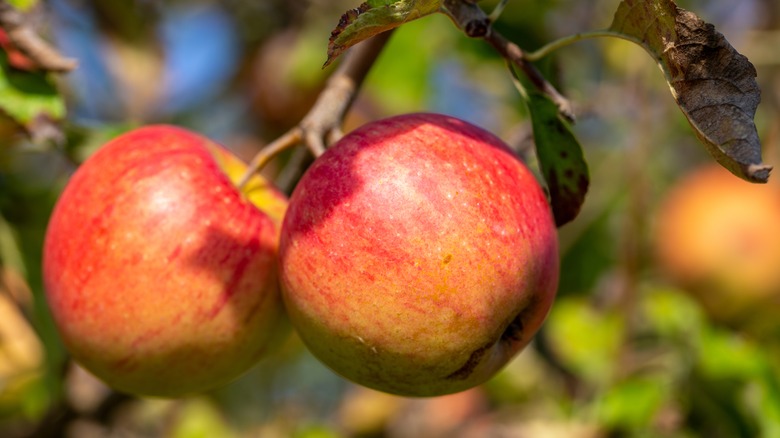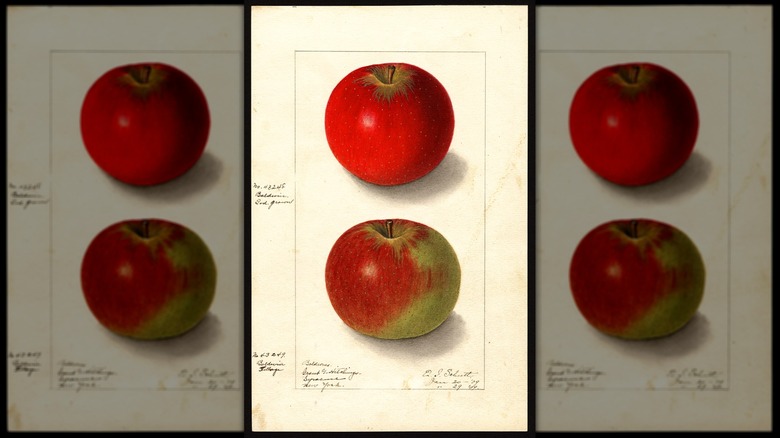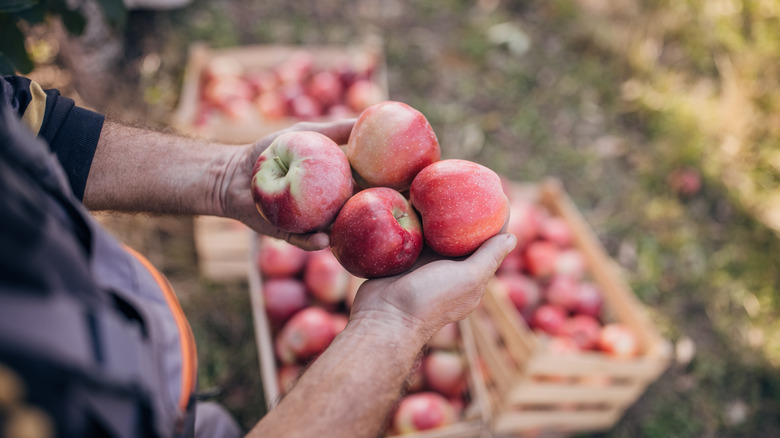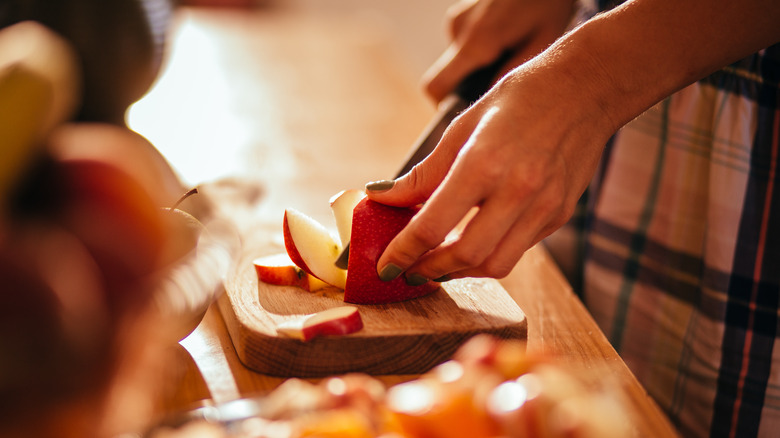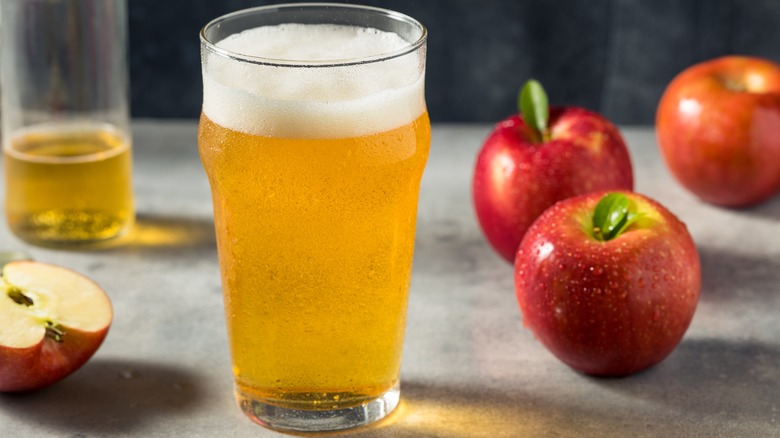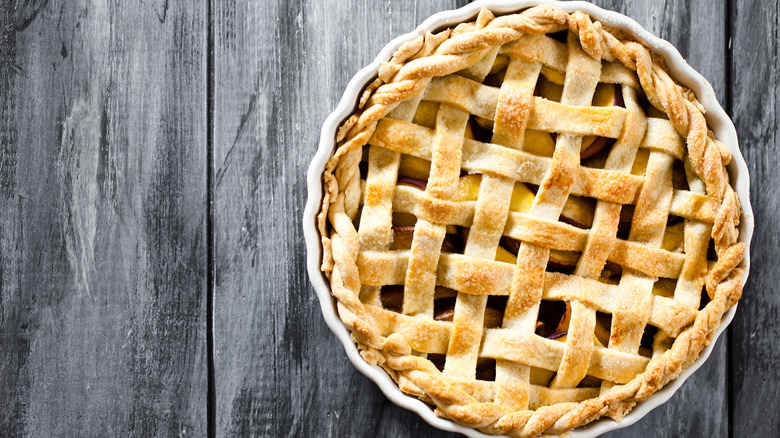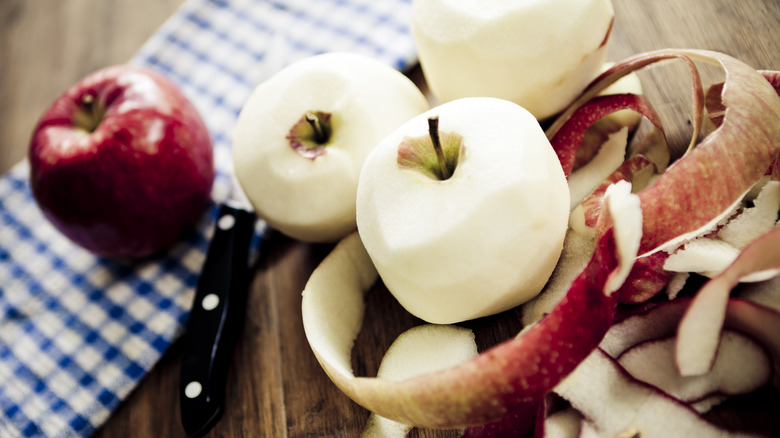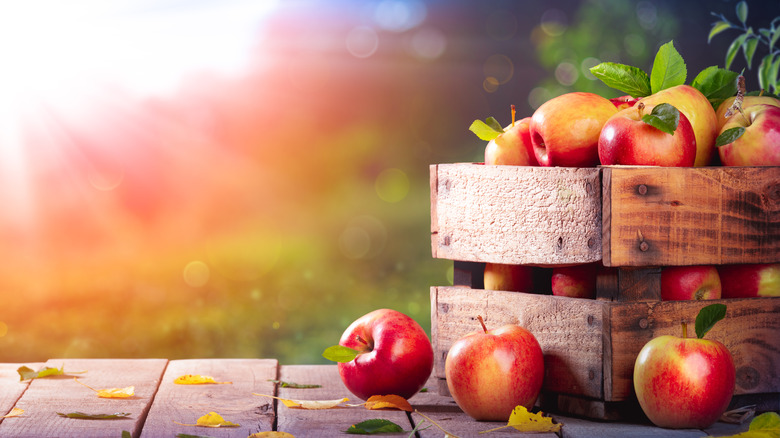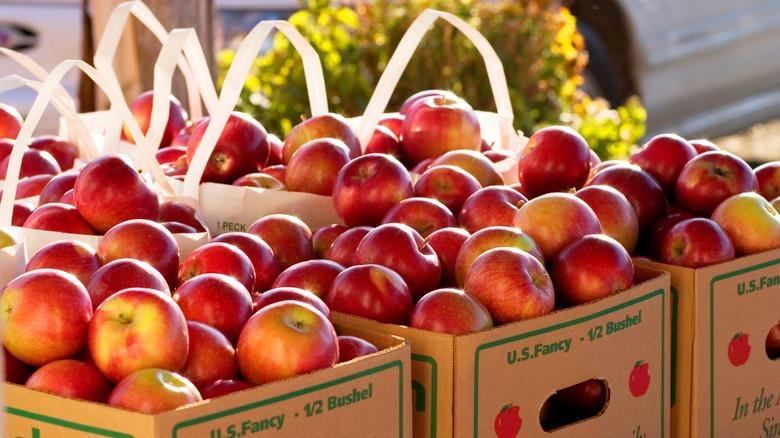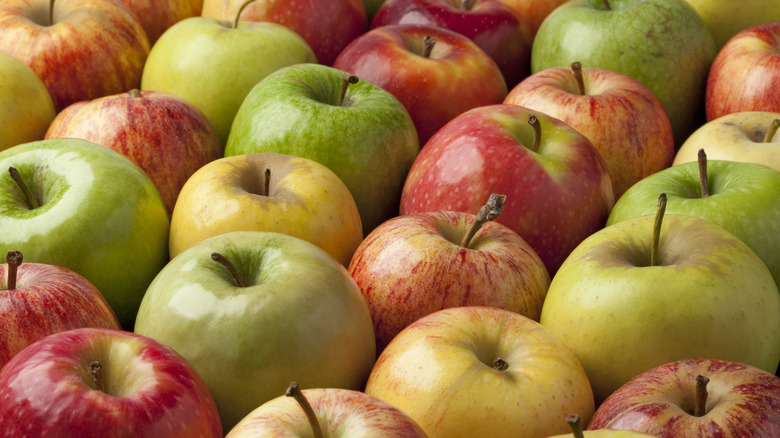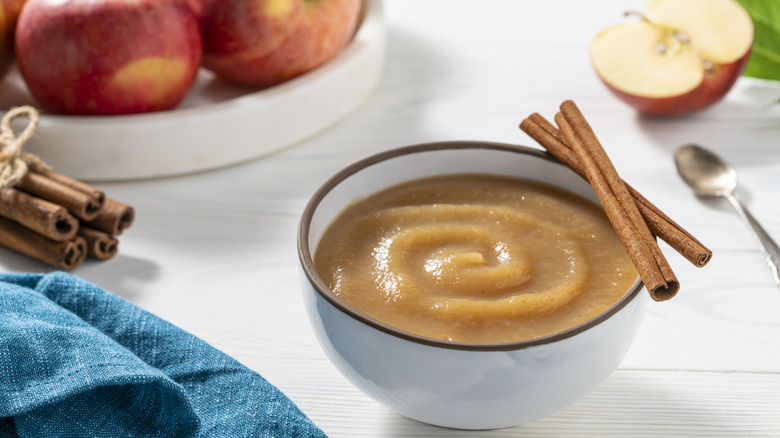What Are Baldwin Apples And What Do They Taste Like?
With their sweetness and firm texture, apples have long been a favorite ingredient of cooks and bakers. But among their many varieties, the Baldwin apple stands out for its balance of sweetness and tartness and its status as one of the country's favorite red fruit from the earliest years of the Republic. Although this variety is less well-known today, it was once a superstar of the apple kingdom.
Discovered as a sapling in Wilmington, Massachusetts around 1740, the Baldwin apple was named after Revolutionary War colonel Loammi Baldwin, who became a staunch champion of the variety and helped bring it to prominence. It was one of the most common apple varieties in New England for more than a century, and by 1850, it was one of the most widely cultivated apples in the country. Its thick skin and dense texture meant that it was easily transported out of state, and its large size, red hue, and intense flavor made it attractive to consumers. But its popularity began to trail off around 1934, when a harsh winter wiped out more than two-thirds of its trees. Sturdier varieties took its place, most notably the McIntosh apple, which remains popular, but Baldwin apples remain an excellent choice for bakers and a beloved variety for those who are lucky enough to find them at the grocery store. Keep reading to discover all you need to know about this unique fruit.
What are Baldwin apples?
Baldwin apples are large, with streaks of greenish yellow, a bright red hue on the parts that catch the most sun, and tiny white speckles all over. They are medium-sized compared to today's commercially grown apples, and are recognizable by their sweet-tart flavor. Due to their lengthy history, Baldwins are considered heirloom apples, meaning that they have not been hybridized with other varieties to produce a particular set of characteristics.
Many apples that you find at grocery stores today are hybrid varieties that have been created with various heirlooms to provide a specific flavor, color, and size, but Baldwins have been carefully cultivated without alterations for generations, all the way back to their discovery around 1740. This makes them less predictable in shape and abundance than varieties like Red Delicious and Honeycrisp, but puts them in the coveted category of apples that are revered for their flavor and rich history rather than their uniformity.
They are relatively easy to cultivate
The rise in popularity of Baldwin apples during the late 18th and early 19th centuries can be attributed to several factors, most notably their hardiness and productivity, which set them apart from other varieties that were available at the time. Their resistance to cold was a significant advantage, especially in regions with harsh weather. This characteristic allowed them to thrive in places like Upstate New York, Vermont, and even Michigan and Canada where the colder temperatures would hinder the growth of less robust varieties. When their popularity was at its height, Baldwin apple orchards could be found all the way West into Washington State.
One of the variety's few downsides was also seen as a strength by some. The trees have a tendency to bear fruit in abundance every other year, making them less consistent than other varieties, but highly productive when they are producing fruit. The trees are also productive for many years, which was likely another practical consideration for farmers at the time since it can take years to grow new trees to fruit-bearing age. In addition to their longevity, the trees were notable in the late 18th and early 19th centuries in their ability to produce predictably desirable results. With very few bad years in which entire crops had to be thrown out, their quality was something you could stake a livelihood on.
Their flavor has a broad appeal
Despite their hardiness and productivity, Baldwin apples would never have become one of the most widely purchased varieties in the United States if they didn't taste delicious. These days, you can walk into a grocery store and find an abundance of options for every flavor preference, from sugary Fujis to tart Granny Smiths. In the late 18th and early 19th centuries, however, the pickings were slim. In fact, most of the apples found in the U.S. at the time were grown for making cider, and it was only the wealthiest of colonists who could cultivate so-called dessert apples on their private estates.
The Baldwin apple, which sprang up in Massachusetts of its own volition rather than being a carefully grafted European transplant, is sweet and tart. Though the variety has often been used for cider, its flavor is so delicious that these apples were also purchased for eating fresh and for putting into that most American of dishes—apple pie. One New England publication stated in 1885 that Baldwins were "What the Concord is among grapes [and] what the Bartlett has been among pears." In other words, they were the cream of the crop, the delicacy of the apple kingdom. Aside from their balance of sweetness and tartness, they have a spicy quality that makes them especially delicious with cinnamon. Like other heirlooms, their flavor is more intense than many modern varieties, and has even been described as being reminiscent of wine and roses.
They are known for their use in cider
As with the majority of apple varieties in the 18th and 19th centuries, Baldwins were most often cultivated for cider production. At the time, the young country was consuming copious amounts of alcohol. It has been estimated that, between 1800 and 1830, Americans drank about 23 gallons of alcohol per year on average, 15 of which were hard cider. Considering that children and women drank very little, the average amount that each man was drinking was likely much higher. Even Johnny Appleseed, the champion of apple orchards who is often depicted taking a bite out of a crisp, rosy fruit, planted apples for cider, not for eating.
Baldwins were used for both purposes, but their qualities were particularly prized by cider makers. When fermented, their flavor settles into something aromatic, citrusy, and melon-like, making them more complex and layered than what you might expect from cider today. Even with the many apple varieties available in the 21st century that can be produced on a larger and more predictable scale, some cider makers still turn to Baldwin apples for their unique flavor profile, and several of them use the variety exclusively in some of their products.
They are a classic choice for apple pie
Apple pies may not be an American invention, but they do hold pride of place in our national cuisine. They were even included in what is considered the first American cookbook, "American Cookery" by Amelia Simmons, which was published in 1796. The recipe does not specify which variety of apples is best for pie, but it does include rosewater. Considering that Baldwin apples are often noted for their rose-like flavor, it's no wonder they became a beloved variety for apple pie.
In addition to their sweet-tartness and aromatic flavor, they were also ideal for baking due to their sturdy texture. Unlike other varieties, Baldwins do not collapse and turn into mush when cooked. Instead, they hold their shape, allowing anyone biting into a freshly baked pie to see beautifully sliced chunks of the fruit even when they're buttery and cooked through. This quality makes them stand out even compared to more popular apples that came later. McIntoshs, for example, overtook Baldwins in the 20th century to become one of the most popular apple varieties, but they are known for their soft texture. When cooked, McIntoshs turn quickly to applesauce, making them a less than ideal choice for pie. They might be harder to find than McIntoshs or the perennial pie favorite Granny Smiths, but Baldwins offer a unique contribution to pies that has stood the test of time.
They are better for cooking than for eating raw
When fermented into cider, Baldwins take on a rich, complex flavor. When added to pies, they hold their shape and provide their signature sweet-tart taste. When eaten fresh, however, they are not quite as universally appealing. For one thing, their skin is thick to the point of toughness. Far from being a dealbreaker, this characteristic made them ideal for commercial purposes in the 19th and early 20th centuries, when apples needed to be robust enough to store for long periods and transport over long distances. But it makes them less enjoyable to bite into than more delicate varieties. If you've ever had to make an effort to bite and pierce an apple skin or gotten the leathery skin stuck between your teeth, you'll know what we're talking about.
In addition to their tough skin, Baldwins have dense flesh. This is more desirable than mealiness, but it does make them crisp in the extreme. The thickness of their skin and dense flesh may be off-putting for those who are used to eating more readily available store-bought varieties such as Galas and Fujis. Over time, commercial apples have been carefully bred to be sweeter and have a longer shelf life, while storage methods have grown more sophisticated and transportation has become faster. As a result, you can now purchase soft, thin-skinned apples year-round from all over the world, and our palates have grown to appreciate these varieties over their sturdier ancestors.
They store well
One of the biggest reasons for the Baldwin apple's lengthy tenure as one of the country's favorite apple varieties was their ability to be stored for long periods of time. This was due in large part to their tough skins and dense textures, which make them less susceptible to bruising and rotting. But it was also the result of good timing.
Baldwin apples are categorized as a winter storage variety because they come into season in late October and early November. This timing coincides with the onset of cooler weather, which was a crucial factor for farmers in the late 18th and 19th centuries because they did not have modern refrigeration. Other apple varieties — such as McIntosh, which eventually stole the market from Baldwins, and Cox's Orange Pippin, a popular 19th-century British variety – ripen at the end of summer, giving them ample opportunity to spoil in the warm weather. At the time, the hardiness of Baldwins made them one of the few apple varieties that could reliably be shipped overseas to Europe without spoiling. With modern refrigeration, they will stay fresh for up to four months.
They have many health benefits and lots of sugar
You've heard the saying "an apple a day keeps the doctor away." This maxim was created as an apple propaganda tool during the Temperance Movement, when the demand for cider apples declined and people burned orchards because of their connection to cider. But the crisp fruit is pretty healthy and definitely worth incorporating into your diet. Broadly speaking, a medium-sized apple contains approximately 95 calories and 19 grams of sugar (the unprocessed kind, of course). It also provides more than 14% of the recommended daily intake of fiber, as well as 11% of the recommended daily intake of vitamin C, and 4% of the recommended daily intake of potassium. You'll even get close to one gram of protein.
The nutritional value of apples differs based on variety, and the specific caloric and nutrient breakdown of Baldwin apples is not as readily available as it is for more popular varieties. However, they are about 13.6% sugar, which, when calculated based on the USDA's definition of a medium-sized apple (182 grams), would mean that one Baldwin apple contains about 25 grams of sugar. This is much higher than apples you'd find in the supermarket, highlighting the intensity of its flavors. Under normal circumstances, an apple with that much sweetness would taste like nothing but sugar, but Baldwins are known for their balance of sweetness and tartness.
They might be hard to find if you live outside New England
Although they were once one of the most popular apples in the United States, Baldwins fell out of favor in the early 20th century for several reasons. Chief among them was the historically erratic winter of 1934. Over a 12-hour period in Maine, for example, the temperature rose 77 degrees, from 33 degrees below freezing to 44 degrees Fahrenheit. Four days later, it dropped 50 degrees in 24 hours. As a result, the number of Baldwins in Maine plummeted from 1.8 million in 1930 to 550,000 in 1940. Most of the Baldwin orchards were wiped out, and the state provided McIntosh trees to replace them.
Another reason Baldwins fell by the wayside was the advancements in breeding, cultivation, and refrigeration that ushered in new apple varieties that could be sold on a larger commercial scale. As new options arose in the 20th century, farmers turned to the ones that reliably bore fruit every year, instead of every two years, such as McIntosh. These days, it's hard to find Baldwin apples outside of New England and Washington State.
Luckily for apple enthusiasts, however, Baldwins have seen a rise in popularity in recent decades, especially among small orchards in the Northeast that celebrate heirloom varieties. If you happen to be at a farmer's market in that part of the world between October and February, keep your eyes peeled; you might be lucky enough to find these apples available to purchase.
You can substitute them with other apple varieties if necessary
Given how tricky they are to find, you might not be able to enjoy the unique complexity of the Baldwin apple anytime soon unless you're lucky enough to live in a place where they are still cultivated. But do not despair. Even if you can't get your hands on this beloved heirloom variety, there are other types of apples that can mimic their flavor.
If you're looking for apples to bake with, Granny Smiths are the most popular variety that is widely available. This is due to their tartness and firm texture, which, like Baldwins, allows them to hold their shape even when baked in the oven for more than an hour. However, with only 11 grams of sugar per apple, Granny Smiths are less sweet than Baldwins. With less than half the sugar of the heirloom variety, they will not give you a similar flavor. In contrast, Honeycrisps mimic Baldwins more closely when it comes to flavor, and are also known for holding their shape when baked.
If you have access to heirloom apples, the Northern Spy is frequently associated with Baldwins. Both are winter apples and store well, and both hold their shape when cooked. The Northern Spy is frequently used in apple pie, and it is now more widely available than Baldwin. You can even purchase the variety online.
You can incorporate them into more recipes than pies and cider
Baldwins rose to prominence due to the flavor they produce when fermented into cider and when baked into pies, but there are many other ways to incorporate them into your cooking to get the most out of their aromatic flavor. To celebrate the fruit on its own terms, try baked apples. Instead of covering the heirloom fruit in dough, this option lets them stand alone with nothing more than a streusel topping to dress them up. Due to their sturdy structure, Baldwins are an ideal option for baking whole because they will not collapse.
Another option is to turn them into apple butter. Although they will take longer to cook down than softer varieties like McIntosh, Baldwins provide a floral taste that will set them apart from the run-of-the-mill varieties you can find at the local supermarket.
A third possibility is to make them part of a savory dish. Our recipe for brie apple honey crostini will let the Baldwins shine in all their sweet, rose-scented glory, and will make an arresting appetizer for fancy dinner parties. When sautéed in butter and honey, the apples will caramelize and yield a rich, sweet flavor that will have everyone begging for seconds. Just make sure to peel their tough skins before slicing them.
